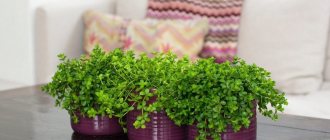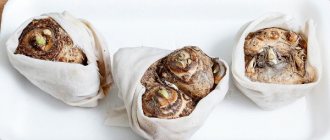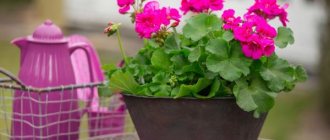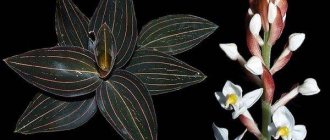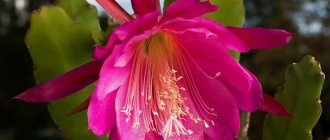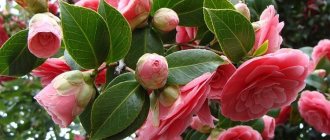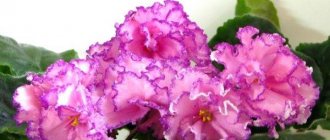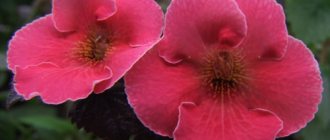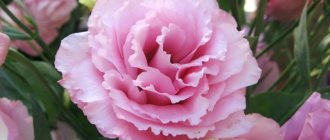Plants from the home collection are four times shorter, but develop just as intensively as “wild” specimens. The shrub lives a long time, but periodically needs rejuvenation, because over time the shoots become thinner and become bare. Ruellia can bloom throughout the summer.
The beauty of the plant lies not only in the bright funnel-shaped flowers, but also in the velvety leaves, “decorated” with light veins. Brazil is considered the birthplace of Ruellia. Its natural habitat is the tropical forests of America and Africa.
Be sure to check out the plants from the Acanthaceae family, Beloperone and Whitefeldia.
| High growth rate. Over the course of a year, the length of shoots increases by approximately 0.25 m |
| Ruellia can bloom throughout the summer. |
| An easy plant to grow. |
| Perennial. |
Description of Ruellia
Ruellia is an exotic flower of the Acanthus family. A flowering annual or perennial plant with delicate and bright inflorescences. Has more than 250 varieties. The plant has a second name - dipteracanthus.
Ruellia prefers warm room temperatures, but only about a dozen varieties take root normally under artificial conditions.
The plant has two types of stems. Different varieties have creeping or erect stems. In addition, certain types of flower grow in the form of a subshrub, bush or herbaceous plant. Under natural conditions, the height of dipteracanthus reaches more than a meter, but under artificial conditions, Ruellia does not grow higher than half a meter.
Of great importance in the design use of ruellia are the flowers, which come in a variety of shades - red, pink, purple, white. In artificial habitats, yellow ruellias are found. The flowers are whorls of several buds growing on a single peduncle. The inflorescences themselves resemble the appearance of bells with the tips of the petals thrown in different directions. The diameter of the inflorescences is up to 3 cm, but there are specimens with flowers with a diameter of more than 10 cm.
Ruellia blooms quickly. The petals of a flowering plant fall off a few hours after opening. However, Ruellia produces a large number of buds, so some flowers quickly replace others, which allows you to admire the beauty for a long time.
The leaves of dipteracanthus are long green blades of grass narrowed towards the edge. They have smooth edges, narrow, and do not reach 1.5 cm in width. The leaves are velvety in color, changing shades. The veins are clearly visible on them. Some species of dipteracanthus have a white or beige stripe on their leaves, running longitudinally along the leaf.
Ruellia is quite unpretentious to grow. Propagates well by cuttings. The plant grows quickly and produces a large number of flowers and foliage, making it popular in design art.
Watering
Moderate, systematic, without fanaticism. The indicator for watering is the dried top layer of soil, and in critical cases, drooping leaves that have fallen down. As soon as the flower receives the necessary portion of water, it will literally begin to come to life before our eyes, lifting its leaves and opening its petals. Does not tolerate drought or excess moisture. For irrigation, settled water at room temperature is used.
Types of Ruellia with photos and descriptions
A large number of species of Ruellia grow in natural conditions. Only about 10 species of Depteracanthus can take root in the home environment.
Ruellia brittoniana
A large sized plant variety. Can grow at home, in large pots. The height of the flower reaches about a meter. A plant growing in its natural environment has a peculiarity - individuals of one species are grouped into several bushes and grow separately from other varieties. The peculiarity of this flower is its evergreen bushes with woody stem bases.
The stems are branched, along which leaves grow densely. The flowers of the plant are raspberry-lilac. The petals bending from the base are lighter than the inside. It blooms almost constantly, since some fallen flowers are almost immediately replaced by others.
The leaves of dipteracanthus give the bush an equally special appearance - in good lighting they become metallic, and when darkened they have a bluish tint. The leaves of the plant themselves are bright green and densely fill the entire bush, giving the latter an attractive appearance.
Ruellia devo or devosa or blue ruellia ruellia devosianus
A common type of domestic varieties of Ruellia. This is a small individual with special shades of flowers. This species blooms in autumn and winter. The buds are gray-blue in color, which is how the variety got its name. The height of the plant does not exceed half a meter.
Ruellia devosa has large petals on the bud, reaching 7 cm. The beauty of dipteracanthus is that at the edges of the flower the petals turn white or lilac. This makes ruellia even more attractive.
The leaves of this variety are elongated, the widest part is in the middle. The leaves are arranged in a circle around the stem, opposite each other.
Ruellia portellae ruellia portellae
In its natural environment, the plant can be seen in the southern part of America. According to the description, this species is similar to Dipteracanthus Devos, but has a special structure of leaves and a large bush size. The plant has bright green, wide leaves. The leaves of this variety are round in shape. Ruellia is grown as an annual ornamental plant that blooms in autumn.
You will be interested in: Tradescantia - methods of growing and varieties of unpretentious flower
Dipteracanthus is attractive at any time of the year because its leaves are dark green. The foliage of the plant densely covers the trunks, which is why the crown has an unusual inflorescence. In the middle of each petal there is a light vein, which gives the flower elegance and beauty, an attractive appearance. The bottom of the petal has a burgundy color.
The flowers of the plant are white, pink and purple, shaped like a bell, with a long bud base.
Ruellia makoyana ruellia makoyana
Perennial plant, up to half a meter high. It has erect large stems along which the foliage is arranged in a circle. The leaves of the plant are oval-shaped, with a bright white vein in the middle. The bottom of the leaf is colored purple.
Ruellia blooms mainly in autumn. At the same time, the buds are bright pink or delicate lilac in color. The diameter of the flowers does not exceed 5 cm. According to the description, the plant is similar to the large-flowered dipteracanthus, but more elegant and beautiful.
Ruellia caroliniensis ruellia caroliniensis
The most common variety of Ruellia, used in decorative arts. A herbaceous variety that prefers to grow in the tropical zones of America and Asia. Low-growing, in artificial conditions the height does not exceed more than 40 cm. This variety easily tolerates darkening and insufficient lighting, therefore it is popular as a domestic variety.
The leaves of dipteracanthus are pinnate, dark green in color with a clearly visible longitudinal vein. The leaves are oval in shape with a convex center. The plant blooms in August-January. The buds are colored bluish-gray, less often dark blue.
Carolina Ruellia is distinguished by its ability to easily take root in dry places, provided that the soil is regularly watered. Therefore, the flower is widely used in home cultivation.
Large-flowered ruellia ruellia macrantha
The plant predominates in the tropical zone. It can be found in its natural environment in the Brazilian tropical zones. This species is well suited for growing in garden conditions and on balconies. The difference between Ruellia grandiflora and others is the large size of the flowers. The flowers are painted in bright pink shades, sometimes with a purple tint. The diameter of the bud reaches up to 13 cm.
A variety of large-flowered dipteracanthus is a shrub plant, up to 2 m high. Ruellia spreads its branches widely, along which narrow, elongated foliage grows abundantly. The length of the leaf reaches 15 cm. The top of each leaf is lowered downwards.
Ruellia is nice
The plant thrives in open areas in the tropical and subtropical zones of South America. Dipteracanthus differs from all other species in its inflorescence, which contains several buds.
Ruelia pleasanta is a subshrub, about half a meter high. It has elongated leaves that are widened towards the center and narrowed towards both bases. The leaves of the plant are even green in dark tones, up to 12 cm in length and about 4 cm in width. Unlike many varieties, Ruellia pleasanta does not have a light stripe in the middle of the leaf.
The flowering of dipteranthus lasts almost the whole year. The flowers of the plant are cherry-colored with brown veins. The diameter of each bud is about 3 cm. After two years of flowering, the plant stops growing and grows.
Tuberous ruellia
Biennial herbaceous plant. Dipteracanthus has a thick, carrot-like root. The stems branch in different directions. Abundantly covered with rich green leaves, without a white stripe in the middle.
The variety blooms in autumn with purple flowers. The size of the buds is about 6 cm in length, and the diameter of the flower is about 4 cm.
Trimming
Since the plant grows very quickly and can turn into a large bushy ball in less than a year, it needs regular pruning. A total “haircut” is usually done in early spring - bald shoots are completely cut off, the remaining branches are shortened to the desired length necessary to create a voluminous crown.
The peculiarity of cultivating ruellia is that it can take both a hanging form and a bush form. Accordingly, the approach to pruning will be different. In the first case, the length of the stems is controlled, in the second, 2-3 growth buds are pinched to form a spherical crown.
Caring for ruellia flowers at home
Ruellia takes root well in artificial conditions. It is quite unpretentious, but if the conditions optimal for the plant are not met, it may die or stop producing color. You don’t have to pay attention to the plant every day, but you should adhere to regular inspection of the ruellia and moistening the soil. Some species tolerate dry or, conversely, very moist soil well.
Location and lighting
The location of the flower in the room is of great importance in growing ruellia. Insufficient lighting and incorrect location cause the flower to stop blooming. Dipteracanthus does not like drafts, so it is important to provide it with a barrier from the wind. At home, it is necessary to provide the plant with good lighting throughout the year. Ruellia does not tolerate smoky rooms, so you should not place the pot in the kitchen or in a smoking area.
In an artificial habitat, growing Ruellia should take place in a well-lit room. The optimal place for the flower to grow in summer is the eastern part of the room. When placing Ruellia on the south side, the plant should be shaded, since direct sunlight can leave burns on the dipteracanthus. In winter, the flower is placed on the south side to ensure good lighting. In winter, for good growth of dipteracanthus, it is necessary to use additional light sources.
Temperature
The normal temperature that dipteracanthus tolerate well is the range of 16-25 degrees. Therefore, the plant tolerates room temperatures well. In winter, the plant should be sheltered from drafts. In summer, dipteracanthus can be placed on a balcony or near an open window. This will allow the leaves and stems to receive a large amount of oxygen. Ruellia, although unpretentious in cultivation, does not tolerate sudden temperature fluctuations. Therefore, you should not place the flower on cold places or window sills.
You may be interested in: Bougainvillea
Watering
The plant prefers to grow in constantly moist soil, so it is worth paying great attention to regular watering of the flower. In order for Ruellia to be constantly in bloom, it is necessary to water it at least once a day, abundantly.
In winter, when the air temperature drops, the amount of watering should be reduced so that the plant does not get sick. However, you should also not overdry the soil. In summer, the frequency of watering, on the contrary, increases and continues until flowering stops. Dipteracanthus should be watered with water at room temperature. The water must be clean and settled, and have a low hardness level.
Air humidity
Since Depteracanthus is native to tropical zones, it is accustomed to growing in constant air humidity. You should regularly humidify the air around the flower. It is quite difficult to achieve this at home, so you need to place a tray with water under the flower pot. You can put a humidifier in the room. This will ensure constant moisture around the ruellia. In garden growing conditions, Ruellia feels good near bodies of water.
Feeding and fertilizers
Ruellia needs constant feeding. It is necessary to fertilize the plant at least once every two weeks. Mineral complexes for flowering plants are used as the main fertilizers. In addition, you can water the plant with a mixture of mineral fertilizers during transplantation of dipteracanthus. If this is done, then soil fertilization should be reduced to 1 time per month. The flower should be fed only during warm weather. After the onset of frost and before the onset of spring, feeding stops.
Transfer
The plant should be replanted as the flower grows out of the pot, but at least once a year. After the flower grows and reaches three years of age, transplants are carried out every 3-4 years.
The most suitable time for transplantation is spring. When replanting annually, you need to take a pot with a slightly larger diameter than the previous one. The plant likes slightly cramped pots. In free conditions, the flowering of Ruellia stops or decreases.
Transplantation of dipteracanthus is carried out by transferring all the roots of the plant with all the remains of the soil mixture on the roots. In this case, there is no need to touch the roots, leaving the soil on them unchanged.
The soil mixture for growing dipteracanthus should be light. A prerequisite for growing ruellia is soil breathability and neutral acidity. A good composition for the soil is equal proportions of leaf soil, humus, turf, peat and sand. You can also buy a special soil mixture in stores.
Trimming
With regular pruning of old shoots, dipteracanthus will constantly renew its branches and produce new leaves. Therefore, it is worth regularly pinch out old branches of ruellia - this stimulates the growth and thickening of the flower’s foliage, and the rejuvenation of dipteracanthus.
Transfer
Transplantation of young specimens is carried out annually, in early spring.
This is done to increase space for roots and partially renew the soil. You need to take a pot a little larger than the previous one. But do not overdo it, otherwise the plant may not bloom, having spent all its energy on increasing the volume of the roots. Mature plants, more than 3 years old, are replanted as needed. This may be interesting: Caring for an indoor rose from A to Z
The soil
Soil quality is the second most important aspect of caring for Ruellia, after air humidity. She definitely needs light, air- and water-permeable soil for flowering plants. Acidity should be close to neutral. It’s easy to prepare the substrate yourself:
- peat - 1 hour;
- humus - 1 hour;
- light leaf soil - 2 hours;
- turf soil - 2 hours;
- coarse sand or perlite - 2 hours;
Heat the resulting mixture in a water bath for 10 minutes to disinfect it.
Step-by-step transplant process
- Prepare a pot 3-4 cm larger in diameter than the previous one. There must be drain holes at the bottom. Place a layer of expanded clay or small pebbles on the bottom.
- Carefully remove the earthen ball with the plant from the old pot. Be careful not to damage fragile stems and leaves. There is no need to shake off the earthen ball so as not to damage the roots. If the plant shows signs of root disease, carefully shake off the soil and carefully inspect it. Take a sharp knife, disinfect it with alcohol or boil it, and cut off all rotten or dried roots, taking 2 cm of the healthy part. Sprinkle the cut areas with crushed charcoal or activated carbon.
- When replanting, it is useful to mix dry complex fertilizers into the soil. This way Ruellia will be able to receive nutrients directly from the soil throughout the growing season.
Provide a support if you want the stems to grow upwards rather than hang out of the pot like a hanging plant.
Reproduction
Ruellia does not require permanent replanting. However, it quickly loses its attractiveness and grows. To prevent the species from withering and completely disappearing, gardeners use various types of Ruellia propagation. This will renew the flower and preserve the variety.
Cuttings
The most popular way to propagate ruellia is to divide the flower into cuttings. Dipteracanthus easily takes root by cuttings. To do this in the spring, you need to cut off a flower branch at least 5 cm long, with a shoot on it. Then put the new sprout in water.
After germination and the appearance of young roots, ruellia is transplanted into a moist soil mixture. In the early stages of propagation by cuttings, it is worth maintaining high temperatures, at least 23 degrees. It is necessary to plant several sprouts in one pot to ensure that the space is cramped. This will allow the flowers to bloom faster.
Layerings
To propagate ruellia by layering, it is necessary to bend the branch with the shoot to the ground as much as possible. It is necessary that at least one shoot comes into contact with the soil. Then you need to secure the plant in this position with a bracket or paper clip so as not to damage the main stem. After germination and the appearance of roots, you need to cut off the shoot from the stem.
Seeds
Another popular method of flower propagation is seed propagation. To obtain seeds, you need to press your hands on the ripened and yellowed boxes and collect the seeds.
The seeds should be planted in nutritious soil that allows plenty of air to pass through. All seeds should be spread on the surface and then lightly sprinkled with soil. After which it is necessary to cover the resulting pot with seeds with cellophane to form condensation. Until sprouts appear, keep the pot in a dark, warm place.
After the sprouts appear, the covering material should be removed and the pot should be placed in a well-lit place. The sprouts should not be exposed to direct sunlight, so the optimal place for placing them is eastern or northern windows. After more than two leaves appear on the shoots, they are transplanted into separate pots.
Dividing the bush
Ruellia varieties that grow as shrubs are easily propagated by dividing the bush. To do this, the bush should be dug up and divided in such a way as not to damage the main thick roots. Then the resulting shoots are planted in permanently moist soil to a depth of at least 3 cm. After about a month, the plant will produce new shoots and fluff up.
You might be interested in: Asplenium
Possible difficulties when growing Ruellia
The plant quickly fades, so to preserve its beauty, several ruellia bushes of the same species can be planted in one oblong pot at once to preserve the composition for a long time.
With the loss of leaves and yellowing of the stem, the plant may wilt or lose its original beauty. It is necessary to make sure that the flower is not exposed to cold air and temperature changes. Usually, eliminating this cause leads to restoration of the flower.
If there is insufficient moisture in the air, the leaves of the plant may curl. It is necessary to place an open container with water near the pot, then the flower will be beautiful again.
As diptreacanthus grows, it becomes insufficient for space in the pot. The plant loves close quarters, but if there is excessive pressure on the roots, the flower ceases to receive a sufficient amount of nutrients. The stem suddenly stretches out and the leaves fall off. It is urgent to transplant the pot into a larger one. At the same time, bare shoots must be pruned, renewing and rejuvenating the plant.
Thin and small leaves and upward-stretching stems are the result of low light for the flower. To solve this problem, you should move the flower to the windowsill on the south side or use lamps for additional light.
Dipteracanthus is a heat-loving plant, however, if temperatures are too high, spots may appear on the leaves of the flower, indicating that the bush is hot. It is necessary to provide the flower with a comfortable temperature to avoid loss of flower attractiveness and reduction of buds.
Possible problems
Diseases
- If the tips of the leaves begin to dry, and the plate itself becomes covered with small brown spots, this indicates that the humidity in the room is too low, or the light is too bright. Shade your pet from the sun and adjust the atmosphere in the room.
- With a lack of fluid and excess sunlight, the leaves begin to curl and dry out.
- If the shoots begin to stretch, and the leaves and buds lose their brightness, the plant does not have enough light. If natural is not enough, buy special lamps for additional illumination.
Pests
Of the pests that can harm Ruellia, the most common are spider mites and whiteflies.
Spider mite
Spider mites do not exceed 5 mm in length and settle in the soil, leaf axils and along the walls of the pot. The plant becomes covered with yellowish spots, and a sticky white web appears on the underside of the leaves.
If the plant is severely damaged, entangled in cobwebs from top to bottom, and most of its leaves have dried out, destroy the bush and soil.
If ticks have just appeared, proceed as follows:
- Wash the plant under a warm shower, after wrapping the pot in a plastic bag so that the soil does not become soggy.
- Collect adult specimens with your hands, using a damp cotton swab to help you.
- Treat the plant with your chosen folk remedy. For example, with garlic infusion: pour 2-3 finely chopped heads of garlic with a liter of boiling water, cover the container with a lid and leave in a cool, dark place for 5 days, then dilute with water in a 1:1 ratio.
- When folk remedies do not help, seek help from acaricides. These are “Aktellik”, “Fitoverm”, “Flumite”, “Neoron”, “Skelta”.
Whitefly
Whitefly larvae attach to the underside of leaves, bite through the tissue and feed on the juice, secreting a sweetish sticky liquid - a medium for the development of sooty fungus.
- If there are few pests, spray the plant with warm water or use a glue trap.
- If the individuals have managed to reproduce, try spraying the plant with a soap or tobacco solution, infusion of yarrow, garlic, or fresh dandelion.
- It is also allowed to use chemical preparations: “Aktellik”, “Aktara”, “Fufanon”, “Karbofos”, “Zeta”, “Rovikurt”, “Inta-vir”, “Fitoverm” in an increased dosage (10 ml per liter of liquid).
When treating a plant against pests, do not forget about precautions. Protect your hands, eyes and mouth, do not eat or smoke during the procedure, keep windows open, and keep small children and pets away.
Thanks to its unpretentiousness in care and benefits, ruellia is appreciated by many gardeners, and it is gradually gaining more and more popularity. The rich colors of its buds and leaves will add a touch of coziness to both the home and work atmosphere, and will add sophistication and gloss to the surrounding environment. Get this overseas miracle at home and you will be guaranteed aesthetic pleasure!
Diseases and pests
Ruellia is a fairly resistant plant that is little exposed to pests and infections. However, in some situations, dipteracanthus may be attacked by insects, including:
- spider mites;
- aphid;
- whiteflies.
To control pests, you should use special products sold in stores - insecticides.
Also, if the plant is not properly cared for, it can be damaged by powdery mildew and gray rot. In the first case, a white coating appears on the leaves, and the leaf itself dries out. In the second, brown dots appear on the flowers, and a gray downy growth appears on the foliage. For treatment, diseased leaves should be removed, cut areas should be treated with charcoal, and the plant itself should be treated with a fungicide. After which it is necessary to additionally fertilize the dipteracanthus.
Interesting Facts
- Ruellia is poisonous, but at the same time it is used as a medicinal plant. Its juice is used for ear diseases, a decoction relieves itching due to scabies, and ulcers are treated with ground leaves. It is highly not recommended to use any parts of this flower yourself. This should be done by an experienced homeopath.
- Ruellia juice contains saponin (a complex organic compound). In its raw form, it is a strong irritant to the mucous membranes of the gastrointestinal tract. Excess of this substance causes dizziness, vomiting and diarrhea.
- It is better not to place the pot with ruellia in places accessible to small children and pets. When replanting and pruning, wear gloves.
Ruellia is a rather rare plant, but once you become its lucky owner, you will fall in love with it once and for all. And all the efforts spent will more than pay off when one day beautiful flowers bloom, replacing each other, like in a magic kaleidoscope.
When does Ruellia bloom?
Under optimal living conditions, most Ruellia species bloom within 3-4 months. Flowering occurs in the autumn-winter period. Usually, from mid-spring to the end of August, dipteracanthus grows rhizomes. All the plant’s energy goes into root growth, so there are no buds.
Ruellia blooms for a very short period of time. Within a few hours, a freshly blossomed flower withers and falls off. A new one will soon take the place of the old one. With the right approach and care, flowering will continue for a long time. At the same time, it is almost imperceptible that the flowers have withered and fallen off.
Features of plant flowering
Dipteracanthus rarely blooms. Flowering lasts no more than two months, while an individual flower blooms and falls in one day.
An open bud pleases the eye for only a day
Period of activity and rest
The active period of ruellia is from March to November or December. In winter, the plant requires a period of rest to gain strength. During this period, the pot is removed to a shaded place and the temperature is lowered. Watering and fertilizing are also reduced.
Types and shape of flowers
The flowers are tubular at the base and open towards the ends. They are small in size, the bud diameter is no more than 10-12 cm. The flowers are located on the top of the shoots and are colored light purple, white, beige or purple.
Medicinal properties
Despite its attractive appearance and decorative use, the flower has also found use in folk medicine. The chemical composition of dipteracanthus includes saponin, a poison that is used to treat certain diseases. Traditional medicine uses dipteracanthus juice in the treatment of pathologies such as:
- ear pain - juice from the stem of ruellia is instilled into the auricle;
- relieving itching and inflammation due to scabies - a decoction of the plant has healing properties. At the same time, they take baths with a decoction or wipe the affected areas of the body with infusion;
- the leaves are rubbed and applied to damaged areas of the skin;
- The smoke produced by burning the dry stems is used to treat headaches.
Despite its beneficial properties, the plant is used more for decorative purposes. This is explained by the beauty and splendor of the flower.
Air humidity
Ruellia needs high air humidity. The ideal figure is 75-80%. In the absence of proper conditions, you need to use humidifiers to help, and also regularly spray the foliage with warm water. Water procedures include wiping the leaves with a damp cloth and dousing them in the shower.
Another method allows you to create optimal humidity - using wet peat, sphagnum moss or ordinary expanded clay. The drainage is poured/placed into the tray of the container where the flower is planted. In winter, the plant is removed from window sills located above radiators or heaters. If this is not possible, then cover the heating devices with a sheet, blanket or any thick fabric.
Signs and superstitions about Ruellia
Ruellia is unpretentious and elegant to grow, but requires a lot of attention. Therefore, people create and believe in superstitions associated with the plant. So, dipteracanthus should be grown in apartments without small children. It is located indoors, protecting the home from evil spirits. In addition, dipteracanthus is considered a symbol of happiness in the home. The presence of a flower in the room carries a talisman against terrible diseases.
To summarize, it is worth concluding that dipteracanthus is a plant of incredible beauty and splendor. Due to its decorative properties, it is used in design art. Flower varieties make it possible to enjoy new colors and comfort in your home. With proper care and timely rejuvenation of the bush, it will delight you with its splendor and decorativeness for a long time.
The soil
Ruellia is an unpretentious flower, and purchased soil will suit it. But it is best to combine turf, humus, sand and leaf soil in proportions 2:1:1:2, and also do not forget about good drainage. Expanded clay, vermiculite or brick shards are suitable.

